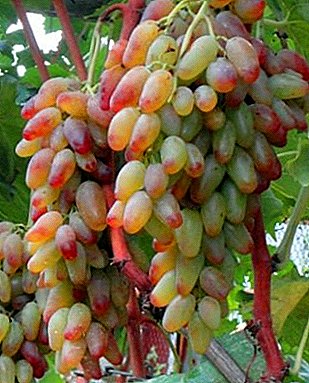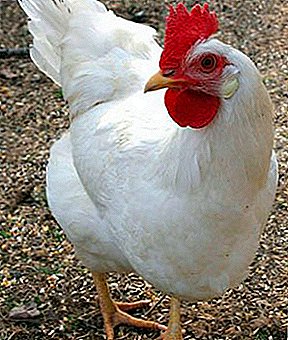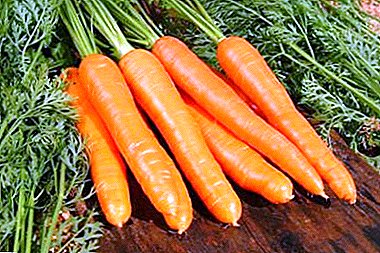
Among other garden crops, carrots stand out as a vegetable that is hardest to preserve for a long time. There can be many reasons for poor wintering of a root crop: from improper agricultural techniques of cultivation to high humidity in the cellar.
Mandatory component for any technology of storing carrots - pre-pruned fruits. What is it and why is the procedure needed? Let's talk about this in the article.
Features of the structure of the root
Root skin thin and delicate - this explains their difficult storage. Malicious bacteria easily penetrate through the loose skin, carrots quickly germinate, freeze, or rot. To bookmark for the winter, be sure to pick only dense and healthy fruits, on which there are no traces of mechanical damage, diseases.
 Carrots are 80% water. Sharp temperature fluctuations, excessive humidity or dryness in the room, dampness, poor cleaning of the basement - a complex of factors leads to the fact that the water from the fruit begins to evaporate (carrots become soft and flabby). Suitable storage conditions:
Carrots are 80% water. Sharp temperature fluctuations, excessive humidity or dryness in the room, dampness, poor cleaning of the basement - a complex of factors leads to the fact that the water from the fruit begins to evaporate (carrots become soft and flabby). Suitable storage conditions:
- storage temperature - 1-2 degrees above zero (for more information about the storage temperature of the root can be found here);
- humidity indicators - 90-95%;
- moderate level of ventilation (no drafts).
REFERENCE! Root crop is better to lay in the winter in the pits, cellars, basements.
Reliable long-term storage will provide a room with artificial ventilation of air, where a constant temperature and humidity are maintained. Before harvesting, be sure to dry and cut the tops of carrots.
We select suitable varieties for harvesting
One of the conditions for high-quality preservation is the selection of suitable varieties and hybrids. To bookmark for the winter, it is recommended to pick up mid-season or late-ripening species. Early varieties poorly retain moisture and are suitable for immediate use - eating or preserving.
When choosing planting material, it is advisable to pay attention to the packaging - here the average time of ripening is always indicated.
General requirements for fruits: the correct form, high yields, intended for long storage. With proper technology, carrots will remain fresh up to 6-8 months.
Which varieties to choose:
- Forto.
- Vita Long
- Shantane.
- Queen of autumn.
- Karlen.
More details about which carrot varieties are best suited for storage can be found here.
What is pruning: the purpose of the procedure
 Before the pruning procedure is harvesting and drying. When digging it is forbidden to beat carrots against each other, shaking off the ground. This leads to microcracks, violation of integrity and reduction of shelf life. If washing of fruits is required, then after washing it is necessary to dry the crop well (keep hanging in warm air for at least 1-3 days).
Before the pruning procedure is harvesting and drying. When digging it is forbidden to beat carrots against each other, shaking off the ground. This leads to microcracks, violation of integrity and reduction of shelf life. If washing of fruits is required, then after washing it is necessary to dry the crop well (keep hanging in warm air for at least 1-3 days).
Pruning carrots is to remove the top green part. Such a procedure will help to preserve useful components in the fruit, stop the processes of rotting and drying out. If you leave the tops, it will actively grow, taking water and nutrients from the fruit. It is necessary to carry out pruning, proceeding from the purposes and the period of storage.
- The term does not exceed 3 months. Pruning green mass 2-3 cm above the vegetable head.
- 2-4 months. Further use - for receiving seeds. Crop is identical to the first option.
- Long storage (until next season). It is necessary to trim the tops together with 2-3 mm of the root of the root. This will stop germination, carrots retain juiciness and taste.
Do I need to remove the tops to keep in the cellar?
Cut off the green part is mandatory for any technology of storing carrots. If the carrot remains for the winter in the ground, the tops are cut, without affecting the root itself. For storage in the basement, you need to cut off the greens and remove the growth point - cut off 2-5 mm from the top edge of the fruit, wash the roots if desired.
How to prepare a carrot for wintering: detailed instructions
 Preparing carrots for storage is an important stage that needs to be given maximum attention (how to prepare carrots for storage in winter, read our article).
Preparing carrots for storage is an important stage that needs to be given maximum attention (how to prepare carrots for storage in winter, read our article).
It is forbidden to carry out the procedure with hands, tearing or twisting the tops. Be sure to use a sharp knife and do not leave even small cuttings. Due to the clipping of the top of the carrot, the growth points are silenced, germination stops, the original properties and taste are preserved.
How to carry out the procedure?
- Trimming the main green mass. It is necessary to leave a small tubercle, cutting the tops slightly above the top edge of the fruit.
- Dry carrots in the sun for 24 hours.
- Cut 2-4 mm from the root of the root. If there are annular cracks or other lesions on the surface, it is necessary to cut from 5 mm to 1-2 cm.
- Removing the root of the tails, since it is from them begins rotting. The root must be cut in the place where the tail diameter is 5 mm or less.
Further actions - laying out carrots in a single layer on plastic wrap on the ground, drying in the sun for 2-3 hours. During this period, the slices will be covered with a protective crust, which will improve the quality of storage. After that, the fruit is placed on the day in a cool place and only then lowered into the cellar.
You can also learn about the preparation of carrots for storage for the winter from this article.
A photo
Further photos of examples how to cut a carrot: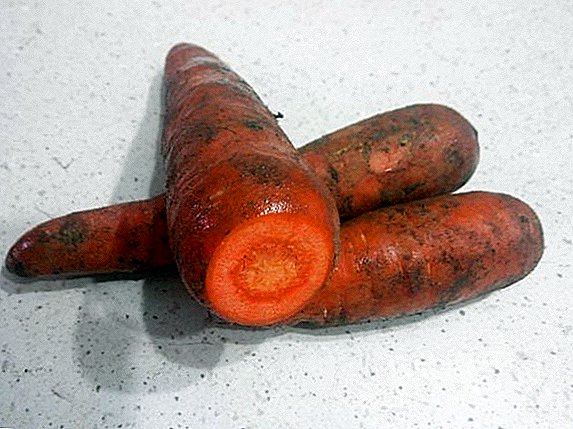

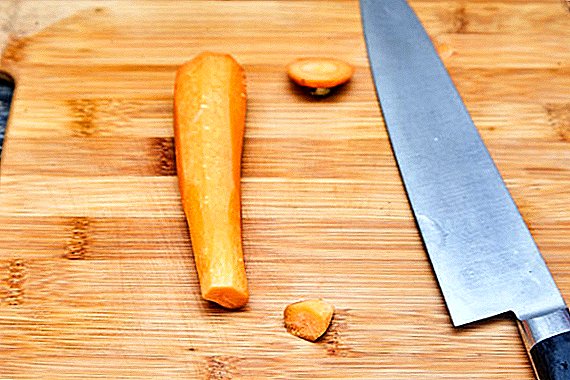
Winter storage methods
High-quality preservation of the root provides space in the sand or sawdust, plastic bags or in boxes of clay. The simplest way is to store in the basement in wooden boxes with a lid. Containers need to be placed at a distance of 10-15 cm from the walls, as the walls may be damp, which will affect the carrots. You need to put containers on shelves or low stands. In 1 box should be placed no more than 20 kg of fruit.
What filler to put in the box?
- Coniferous sawdust.
The material contains phenol, which will prevent rot and other diseases. Carrots are folded in a crate and filled with sawdust.
- Sand.
Root vegetables need to spread on a thick sand pillow (lay a shelf or the bottom of the box). Each new layer needs to be re-filled with sand. It is necessary to use slightly moistened sand.
- Chalk solution.
Chalk must be diluted with water to a uniform consistency. Dip each carrot into a solution, fold it into boxes and store.
- Slurry.
This is a dirty but effective way. Suitable for those cellars in which roots often rot and deteriorate. From clay and water you need to make a talker - a stretching mass. Dip carrots in the solution, dry. Clay should completely cover the fruit. After drying, place the carrots in boxes or baskets, lower them to the basement.
- Plastic bags.
Dry root vegetables need to be folded in tight bags and put in the cellar, put on the floor on protective stands. Make several holes at the bottom of the bags so that the condensate has an outlet. Do not close the bag and do not tie it.
Moss or canvas bags can also be used for storage.
- How to store if there is no cellar?
- On the bed.
- In banks and boxes.
- In a refrigerator.
- On the balcony.
- Can I freeze in a grated form for the winter?
If something went wrong?
 During the entire period of storage of carrots, it is important to ensure that it does not rot, grow, lose taste and product properties. Of the physical processes, evaporation of moisture carries the highest risk. Carrots have a small thickness of the peel, contains many colloids - this affects the intense loss of moisture. Possible outcomes include weight loss, fading, loss of product quality.
During the entire period of storage of carrots, it is important to ensure that it does not rot, grow, lose taste and product properties. Of the physical processes, evaporation of moisture carries the highest risk. Carrots have a small thickness of the peel, contains many colloids - this affects the intense loss of moisture. Possible outcomes include weight loss, fading, loss of product quality.
To prevent such changes, it is important to ensure good air exchange and constant temperature. If rotting has been detected, the affected fruits should be discarded, the place of rotting and the neighboring root crops should be covered with quicklime or chalk. With mass rotting, all carrots need to be sorted out and implemented (used) as soon as possible.
Additional tips and warnings
Primary processing of carrots before storage is cleaning, proper pruning and drying. At the time of harvest, it is imperative to reject the damaged vegetables. After pruning the greens, you need to wait for the formation of a dry peel at the cut point and only then lower the carrots into the cellar.
The final shelf life depends on the chosen technology:
- clay and sawdust will help preserve the fruit before harvesting the new crop;
- wet sand - 7-8 months;
- ordinary wooden containers without filler - 4-7 months;
- plastic bags - 3-6 months.
Regular inspection of the crop, removal of damaged fruit and pruning of the overgrown tops in the basement will prolong and improve the quality. It is important to take into account that the state of tops plays a decisive role during storage. The larger the size of the left hemp, the faster the root will begin to germinate.
ATTENTION! The only unwanted neighbor for root vegetables is an apple. Fruit secretes ethylene, which affects the taste of carrots.
If the basement is frozen, the boxes of carrots need to be further covered with felt or any other insulating material. Small and thin fruits are desirable to use in the first place, as they dry faster. Larger carrots with the right approach will lie until spring-summer. Be sure to isolate vegetables from direct sunlight and moisture.
Pruning carrots before laying for the winter - a mandatory procedure. The quality of storage of the crop depends on the quality of its implementation. Cut the tops with a sharp knife or scissors, leaving no points of growth and hemp. To lower the roots in the basement is necessary only after the cut points are covered with a protective film.


